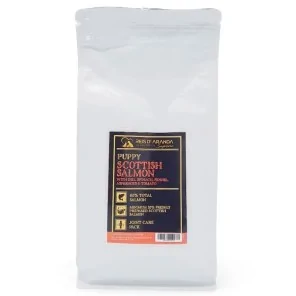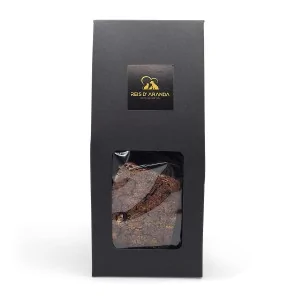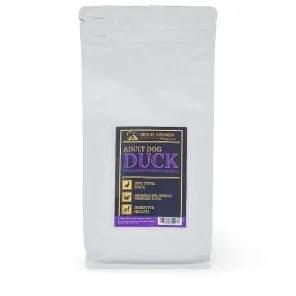Its name says it all: the Vienna blue rabbit comes from Austria. Not only is it beautiful with its shiny blue-grey...
THE FRENCH BULLDOG
INTRODUCTION
The French bulldog is a breed of dog originating in France and established as such in the late 19th century. They were first bred by lace makers in England and then in France when they were displaced by the Industrial Revolution. However, the United States and France have played important roles in the development of this breed.
THE ORIGIN OF THE FRENCH BULLDOG
Descended probably, like all mastiffs, from the Molossoids of Epire and the Roman Empire, a relative of the Bulldog of Britain, the Alans of the Middle Ages, and the pugs and bulldogs of France, the bulldog as we know it is the product of various crosses made by passionate breeders in the working-class districts of Paris in the 1880s. At that time he was the companion of the workers of the central market of Paris - butchers, coachmen - but he soon conquered the high society and the world of artists by his particular physique and his character. It spread rapidly. The first club for this breed was founded in 1880 in Paris. The first registration dates from 1885, and the first standard was established in 1898, the year in which the Société Centrale Canine recognised the breed of the French Bulldog. The first French Bulldog was exhibited from 1887. The standard was modified in 1931, 1932 and 1948. It was reformulated in 1986 by H.F. Réant with the collaboration of R. Triquet (F.C.I. publication of 1987), then in 1994 by Violette Guillon (FCI publication of 1995) and in 2012 by the French Bulldog Committee.
THE STANDARD OF THE FRENCH BULLDOG
GENERAL APPEARANCE : Of a small molosser type. A sturdy dog for his small size, short, stocky, compact in all proportions. Short-haired with snub nose, erect ears and naturally short tail. Must have the appearance of an active, intelligent, very muscular, compactly built dog with solid bone structure. No point should be exaggerated in relation to the others, which would destroy the overall harmony of the dog in appearance and in movement.
IMPORTANT PROPORTIONS: The length of the body from point of shoulder to point of buttock is slightly greater than the height at withers. The length of the muzzle is approximately 1/6 of the total length of the head.
HEAD: Should be strong, broad and square, covered with skin, forming symmetrical folds and wrinkles without excess.
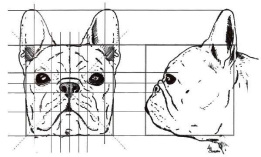
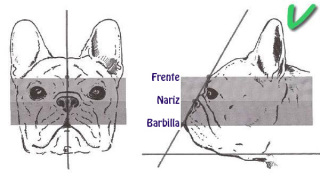
CRANIAL REGION: Skull: Broad, almost flat between the ears; domed forehead. The superciliary arches are prominent and separated by a particularly pronounced furrow between the eyes. The furrow must not extend into the skull. The external occipital protuberance is hardly developed. Stop : Pronounced.
FACIAL REGION: The Bulldog's head is characterised by a contraction of the maxillary-nasal mass and a slight to moderate inclination of the nose towards the rear. The nose is slightly higher at the tip (snub nose).
NOSE: Black, broad, upturned with nostrils well open and symmetrical and sloping backwards. The inclination of the nostrils, as well as the upturned nose, must, however, allow normal nasal breathing
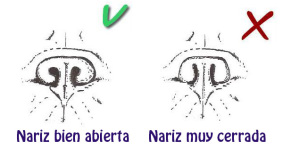
HOCOCO : Very short, broad and with concentrically symmetrical folds.
LIPS: Thick, slightly loose, black in colour. The upper lip joins the lower lip in the centre, completely covering the teeth. The profile of the upper lip is descending and rounded. The tongue should never be visible when the dog is at rest.
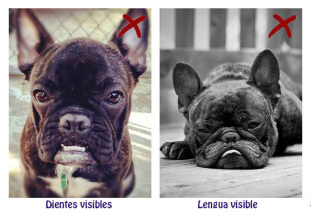
JAWS : Broad and powerful. The lower jaw projects in front of the upper jaw, curving upwards. The arch of the lower incisors is rounded. The jaws should not show lateral deviation or twisting. The separation of the incisor arches is not strictly delimited, the essential condition is that the upper and lower lip meet to cover the teeth completely. The lower incisors are located in front of the upper incisors. Incisors and canines are sufficiently developed. Complete dentition is desirable.
CHEEKS : Well developed.
EYES : Clearly visible, lively in expression, set low, set well away from the nose and ears, dark in colour, rather large, rounded and showing no trace of white (sclera) when the dog is looking forward. The rims of the eyelids should be black.
EARS: Of medium size, broad at the base and rounded at the tips. Set high on the head, but not too close together, carried erect. The pinna should be open towards the front. The skin should be fine and soft to the touch.
NECK: Short, powerful, slightly curved, without dewlap, broadening towards the shoulders.
BODY:
TOP LINE: Rising progressively but not excessively, from withers to kidney. This conformation also called ‘roach back’ is a typical characteristic of the breed.
BACK: Broad and muscular, firm, without laxity.
LOIN: Short, broad and arched.
Croup : Well sloping.
CHEST: Cylindrical and well let down (slightly below the elbows), ribs well sprung, barrel shaped. Broad forechest forming a square when viewed from the front.
BOTTOM LINE AND BELLY: Set on but not set on high.
TAIL: Naturally short, ideally of sufficient length to cover the anus, set on low, rather straight, thick at the base, tapering towards the tip. A twisted, knotted, broken or relatively long tail not exceeding the point of the hock is acceptable. It is carried low. Even in action it should not extend beyond the horizontal line.
LIMBS
FOREQUARTERS:
GENERAL APPEARANCE:General appearance: Correct level when viewed in profile and from the front.
Shoulder: Well laid back.
ARM: Short, thick, muscular, slightly curved.
ELBOW: Close to the body without laxity.
FOREARM: Short, straight and muscular.
BODY: Solid and short.
Pastern: Short and slightly oblique when viewed in profile.
HANDS: Round, compact, small in size, called ‘cat feet’, turned slightly outwards. Fingers are tight, nails short, thick and black.
HIND LIMBS:
GENERAL APPEARANCE: The hindquarters are strong and muscular, slightly longer than the forelegs, thus raising the hindquarters. The hindquarters are correct when viewed both from the side and from behind.
THIGH: Well muscled, firm.
HIP: Rather low. Neither too angulated nor too straight.
HINDQUARTERS: Solid.
METATARSE: Short.
FEET: Round, compact, not turned in or out.
GAIT / MOVEMENT: The limbs move parallel to the median plane of the body, seen both from the front and from the side. The movement is free, powerful and regular.
SKIN: Firm.
COAT :
HAIR: Smooth, close, glossy and soft, without undercoat.
COLOUR: Fawn, brindle or not, with or without white markings.
COAT WITHOUT WHITE PATCHES
ATTITUDE: Fawn coat moderately marked with dark brindle transverse markings giving a ‘tiger-stripe’ effect, the strongly brindle coat must not hide the fawn background. May be presented with a black mask. Moderate white patches are permissible.
Tawny: Coat of solid colour, from light to dark fawn, sometimes showing a more subdued tone on the sloping parts, with or without black mask, although specimens with mask are preferable. Sometimes accompanied by moderate white patches.
MANTLES WITH WHITE PATCHES
ATIGRADO WITH VERY EXTENDED WHITE SPOTS: Called ‘pied’ or ‘caille’, the spots are ideally distributed over the whole body of the dog. Some patches on the skin are permissible.
FAWN WITH VERY EXTENDED WHITE SPOTS: Called ‘fawn and white’, the spots are ideally distributed over the whole body of the dog. Some patches on the skin are tolerated. The nose is always black in all coat colours, never brown or blue. Completely white dogs, provided the nose and rims of the eyelids are black, are permitted but not sought after because of the risk of deafness.
SIZE AND WEIGHT:
HEIGHT AT CRUZ: Males: 27-35 cm. Bitches: 24-32 cm. A deviation of 1 cm below or above the stipulated height is tolerated.
WEIGHT: Males: 9-14 kg. Females: 8-13 kg. 500 gr. more than the stipulated weight is tolerated if it is a typical specimen.
FAULTS:
Any departure from the foregoing points should be considered a fault and the seriousness with which the fault should be regarded should be in exact proportion to its degree and its effect upon the health and welfare of the dog.
- Heavily spotted pied mantles.
- Fawn and white mantles strongly mottled with red.
- In fawn mantles, deep black strokes extending along the spine.
- White boots in brindle or fawn.
- Light coloured nails.
SERIOUS FAULTS:
- Hypertypical specimens, with exaggerated breed characteristics.
- Muzzle too long or too short.
- Tongue visible when the mouth is closed.
- Light eyes (raptor look).
- Horizontal topline from withers to kidney.
- Excessive depigmentation of lips, nose, eyelids, the edges of which can never be totally depigmented.
- Pincer bite.
DISQUALIFYING FAULTS:
- Aggressiveness or extreme shyness.
- Any dog showing clear signs of physical or behavioural abnormalities must be disqualified. FCI-St. N° 101 / 29.09.2015 8
- Lack of type: insufficient ethnic characteristics with the result that the individual does not resemble other dogs of the breed.
- Completely closed nostrils.
- Twisting or lateral deviation of the jaw, resulting in the tongue being constantly visible.
- Dogs with lower incisors placed behind the upper incisors.
- Dogs with canines constantly visible when the mouth is closed.
- Heterochromous eyes.
- Nose of a colour other than black.
- Ears which are not erect.
- Absence of tail or ingrown tail.
- Dewclaws on the hindquarters.
- Inverted hocks.
- Long, harsh or woolly coat.
- Coat of a colour not described in the standard, i.e. black, merle, black and tan and any dilution of black with or without white markings.
- Size and weight outside the permissible limits.
- Dogs with respiratory problems.
- Deafness.
N.B.:
- Male dogs should have two apparently normal testicles fully descended into the scrotum.
- Only functionally and clinically healthy dogs with typical breed conformation should be used for breeding.
BEHAVIOUR / TEMPERAMENT: Companion dog, sociable, happy, playful, possessive and alert.
FRENCH BULLDOG OR BOSTON TERRIER?
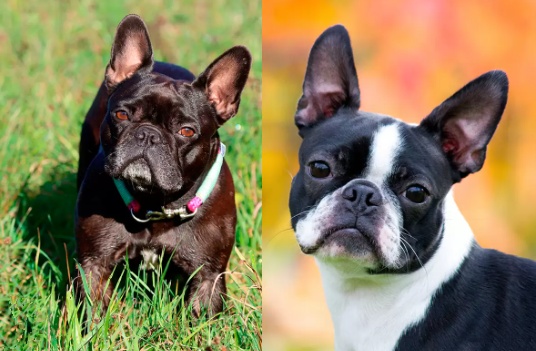
When you have a French Bulldog, you fall in love with him, and you start to see dogs like him everywhere. Then you discover their skinny cousins, the Boston Terrier.
The French Bulldog is a small dog, usually weighing between 10 and 16 kg and measuring about 30 cm. Very muscular, compactly built and solidly boned, their head is square and broad, and their skin forms folds making wrinkles (which must be carefully maintained as they can become infected). His coat is short and soft. It has a courageous and stubborn character.
The Boston Terrier is a smaller dog, usually weighing between 6 and 7 kg and measuring about 30 cm. They are muscular dogs and their ears are also bat-shaped. Their coat is short and smooth. Their life span is also usually about 12 years, they are more agile and easy to train.
THE HEALTH OF THE FRENCH BULLDOG
A French Bulldog from a healthy line of dogs and correct breeding is a fairly healthy dog, but it is important to be aware of the diseases associated with the breed which are controllable with the appropriate health tests, these are essential before breeding.
- BRACHYCEPHALUS DOG SYNDROME: This is one of the most common problems of the French Bulldog and the most widespread. Brachycephalic dog syndrome affects all variants of dog breeds that have a flat muzzle. Sufferers have difficulty breathing normally from birth and it can cause real health problems. To control this we have the BOAS test, which is essential for breeding.
- ENTROPION: This is another of the French bulldog's most common diseases. It consists of the eyelid folding inwards, causing the eyelashes to rub on the inside of the eyelid and damage it.
- HEMIVERTEBRA: It is a malformation of the spinal column, it can cause compression of the nerves causing a lot of pain and mobility problems that can even make them unable to walk.
- SLANTED PALATE: Affects from birth. It causes abnormal communication between the oral and nasal cavities and leads to serious developmental problems, because it prevents them from eating and breathing properly.
- CYSTINURIA: Cy stinuria in dogs is a genetic disorder characterised by inadequate excretion of certain amino acids, particularly cystine, from the kidneys. The accumulation of cystine leads to the formation of cystine crystals and ultimately urinary stones.
- HYPOTHYROIDISM: Hypothyroidism is a common hormonal imbalance in dogs and is usually caused by inflammation or shrinkage of the thyroid gland. This progressive destruction of the gland leads to decreased thyroid function and insufficient levels of thyroid hormones.
- HIP DYSPLASIA: Hip dysplasia is a multigenic and osteoarticular disease that can be hereditary and degenerative. Therefore, there may be different factors with which to try to predict whether the disease can be developed or not. It is necessary to bear in mind that, although it may be a hereditary disease, it does not always have to develop as it is possible that the dog does not transmit it to its descendants.
- ELBOW DYSPLASIA: Canine elbow dysplasia is a condition consisting of multiple abnormalities of the elbow joint. The elbow joint is a complex joint made up of three bones (the radius, ulna and humerus). If these three bones do not fit together perfectly as a result of growth disturbances, an abnormal distribution of weight on different areas of the joint occurs, causing pain, lameness and leading to the development of arthritis.
As they can be prone to allergies and atopic dermatitis, we have to opt for quality feed with a high meat content (no by-products), fish and duck are great choices for them.
CONCLUSION
The French Bulldog is a fun and active breed, its strength and graceful facial expression make it the favourite of many families worldwide but it is important to acquire it in a good place that pays attention to health and avoid as much as possible acquiring dogs of exotic colours or incorrect hair types (long hair).
If we take care of our French Bulldog we can enjoy a great dog for many years to come.
Leave a comment
Log in to post comments

